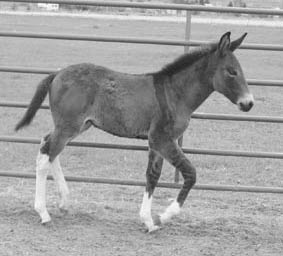Being a breeder and trainer of mules I receive many questions during
the year. One question I am asked a lot is, “Which mule is better, a
john or molly?” We all know people who will only ride a john mule,
or will only ride a molly mule. So, which mule is better?
|
 |
|
COLOR OF A MULE is a
personal preference |
A molly mule generally will have a little more refinement in her
conformation. Usually this will show up in a smaller, more petite
head. The mule’s dam will have something to do with this, but the
jack normally will have more. A jack with a large head will normally
throw a mule with a larger head; jacks with smaller more refined
heads will pass this along to their offspring.
Molly mules will also show heat like a mare although usually not as
bad. Many times you cannot detect when the mule is in heat. I have
seen molly mules that show heat and act just like a mare in heat.
John mules must be gelded or they will act and breed, like a
stallion. John mules are sterile. If not gelded like a horse they
will mount and breed mares and molly mules. We geld all our john
mules when they reach three months of age; some people will geld
earlier and some later. Follow your veterinarian’s recommendation.
John mules are also more playful than a molly mule. They always seem
to be ‘looking for trouble’. I will turn all of my young mules out
together in groups of mules of the same age. The john mules are
constantly running around the pasture, rearing up and playing. You
will see them walk up to a fence and pick on the mules in the next
pasture. They always seem to have little marks and scraps on them
from rough-housing with each other.
Another question I receive a lot is, “What type of mule should I buy
or breed my mare for?” Mules come in many different colors, sizes,
conformations and dispositions. Color is a personal preference and a
question only you can answer. To some people, color is the most
important thing, and others it is the least important.
When breeding a mare to a jack, most jacks will have a lot of
influence in the color of your foal. In 1993 I started a search for
a mammoth jack to start my breeding program. I spent two years and
looked at over 200 jacks before purchasing my jack, ‘Diamond Creek
Major’. He is a black jack with white points. Many of the old time
jack breeders told me that many black jacks carry a dominant sorrel
gene. I purchased ‘Major’ for his conformation and it did not matter
what color foals he threw. As it turns out, ‘Major’ throws black and
bay colored foals, the color I wanted. Personally, color is the last
thing I look at when evaluating a mule.
The size of a mule is another personal preference, but your size
will have some influence in your decision. A large framed person
will not want a small mule. At the same time if you are shorter in
size you may get tired of always looking for a rock in order to
mount your 16 hand mule.
I always look for a mule with good conformation, no matter what I
intend to do with the mule. Even if I am riding down the trail, I
want people to look at my mule and say, “That’s a good looking
mule”. Not only does it make for a nice looking mule, but it also
allows the mule to have a healthier life. It creates less stress on
their body and allows them to perform without creating potential
foot, hock, leg, neck, etc. problems.
Disposition is what I look at next. A mule with a good disposition
usually is easier to train. They will meet you at the gate when you
go to catch them and they just like to be around people. This does
not mean mules with bad dispositions will not make a good mount. The
mule is telling you that it is going to take more of a commitment by
you or a trainer to train the mule.
You will also need to look at the sire and dam of the mule or the
jack and your mare you are breeding. We all know of a thoroughbred
mule that someone has trained to cut cattle or a draft mule that
excels in Dressage. These are mules that someone has spent thousands
of hours of training.
It is much easier to breed or buy a mule from a jack and mare that
is suited to the discipline you intend to use the mule in. Draft
mares for heavy work, quarter horse and paint mares for ranch work,
western pleasure and trail riding and warm blood mares for Dressage,
English and hunter jumping.
So, what type of mule should you purchase or breed for? John or
Molly mule? Sorrel or black mule? Draft or quarter type mule?
You must first decide what you will use the mule for and what ‘type’
of mule you are looking for. Then you must look at each mule as an
individual. Don’t get caught up in stereo typing mules. There are
good and bad in all types of mules. It is no different than the
person that will only ride a quarter horse or paint, or would never
ride a mule.
Tim can be reached at
www.diamondcreekmules.com, or by phone at 307/899-1089, or
email:
bliss@wavecom.net.
|